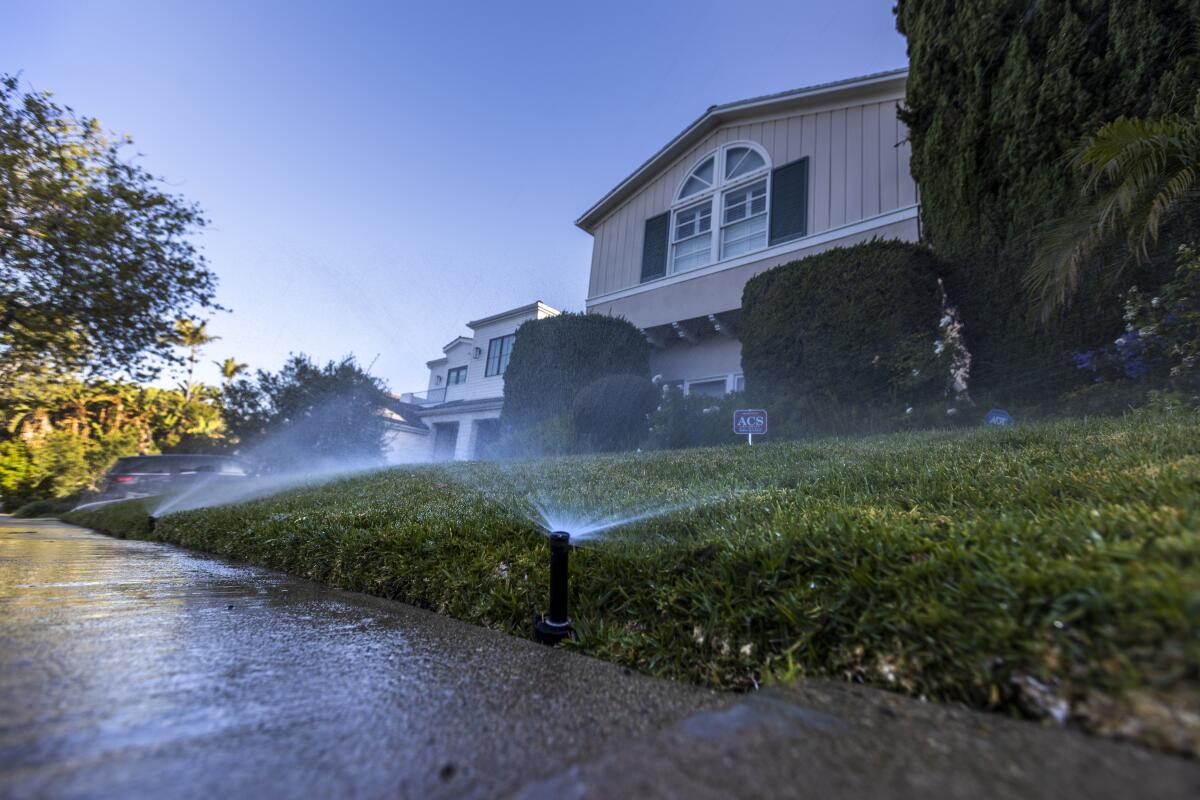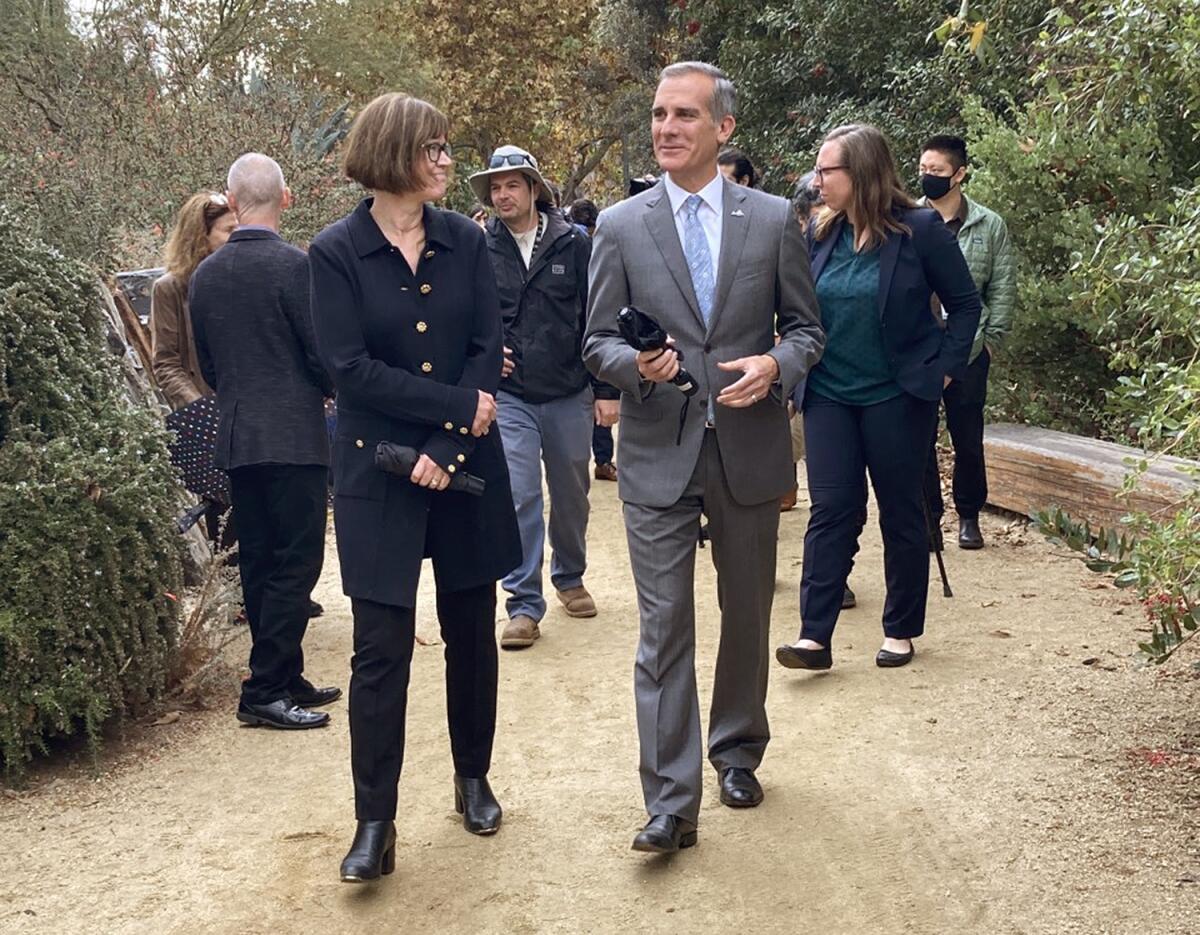L.A. water use plummets during hot summer amid calls to conserve during drought

- Share via
Amid a record-breaking drought and calls to drastically reduce water use across California, Los Angeles residents saved a staggering 6 billion gallons during the hottest months of the summer, officials announced Monday.
From June through September, Los Angeles Department of Water and Power customers used 6 billion gallons of water less than during the same period last year.
The usage is the overall lowest among the city’s nearly 4 million residents during those summer months since record keeping at the agency began in the early 1970s, said Marty Adams, the DWP’s general manager.
“We’ve notched a 9% year-over-year reduction on top of what we had done in the years before,” Mayor Eric Garcetti said at a news conference at the L.A. County Natural History Museum, touting the water conservation numbers.
DWP customers reduced their water use by 9% in June, 11% in July, 10% in August and 9% in September, which all amounted to record low usage during those months.
“We’ve certainly accomplished a lot,” Adams said at the news conference.
Yet politicians and water experts have urged residents to do more as hopes of a wet winter seem unlikely with another year of dry La Niña conditions in the forecast.
The announcement comes after three consecutive months of record water-use reductions following unprecedented restrictions that went into effect in June across the state. At the time, nearly 4 million Angelenos were placed on twice-a-week outdoor watering rules.
The restrictions were triggered when the region’s huge water wholesaler, the Metropolitan Water District of Southern California, declared a water shortage emergency. The State Water Project, which delivers water from Northern California to farmlands and cities to the south, cut its allocation from 15% to 5% this year.

Adams and Garcetti suggested that some of the DWP’s residential water conservation rebates and programs — including soil-moisture sensors, low-water-use toilets and washers, and turf replacement — aided in the conservation efforts.
Garcetti announced last week that the DWP will increase rebates from $3 to $5 a square foot for residential and commercial customers when they replace their lawns with drought-friendly plants.
“This is the time of year to be taking your turf out and replacing it with California-friendly landscapes,” which include native plants from the state, the southwestern U.S., Mediterranean regions, Australia and Mexico, Adams said.
Since 2009, L.A. has replaced more than 51 million square feet of lawn and saved more than 2.3 billion gallons of water as a result, Garcetti said, enough to supply more than 28,000 households with water for a year.
As the drought continues, Californians are tearing out their lawns. Here’s a DIY guide to killing grass to prep for a drought-tolerant landscape.
Although conservation continues to play an important and immediate role in the region’s response, water experts said that improved recycling and infrastructure — as well as enhanced responses from businesses, industry and government — will be needed to reduce reliance on water from Northern California and the Colorado River, a key source of water for Southern California.
L.A. City Councilmember Mitch O’Farrell, the chair of the city’s Energy, Climate Change, Environmental Justice and River Committee, said the city can do more. He is pushing for on-site gray-water reuse systems for new developments over 100,000 square feet and solar panels across the L.A. aqueduct in an effort to reduce water evaporation.
Although a massive storm will bring rain and snow to the region this week, Adams emphasized that residents should adopt water conservation efforts for the long haul.
“Last year, we had a lot of rain in December, and then nothing — nothing happened after that,” he said. “We know this year has been a tough year and that next year will be a tough year. There’s no way around it. So ... we have to protect our way of life.”
Experts say that although the conservation efforts are helpful, they are not enough to sustain long-term water use across the region.
“We have to stop thinking of this as responding to this drought and acknowledge that these droughts are becoming more frequent and severe,” Heather Cooley, director of research at the Pacific Institute, previously told The Times. “Action that we take now — and continue to take even after this drought ends — will be important for the future.”
Times staff writer Hayley Smith contributed to this report.
More to Read
Sign up for Essential California
The most important California stories and recommendations in your inbox every morning.
You may occasionally receive promotional content from the Los Angeles Times.















